Contribution of Cross-Linker and Silica Morphology on Cr(VI) Sorption Performances of Organic Anion Exchangers Embedded into Silica Pores
Abstract
1. Introduction
2. Results and Discussion
2.1. Synthesis of PSi/ANEX Composite Sorbents
2.2. Characterization of PSi/ANEX Composites
2.2.1. Structural Characterization
2.2.2. Thermogravimetric Analysis (TGA)
2.2.3. Morphological and Textural Characterization
2.2.4. Determination of pHPZC
2.3. Sorption of Cr(VI) onto PSi/ANEX Composites
2.3.1. pH Effect
2.3.2. Kinetic Study
2.3.3. Adsorption Isotherm Models
2.3.4. Reusability
2.3.5. Thermodynamics
3. Materials and Methods
3.1. Materials
3.2. Synthesis of PSi/ANEX Composites
3.3. Equipments for Characterization
3.4. Sorption of Cr(VI) onto PSi/ANEX Composite in Batch Mode
4. Conclusions
Supplementary Materials
Author Contributions
Funding
Conflicts of Interest
References
- Owlad, M.; Aroua, M.K.; Wan Daud, W.A.; Baroutian, S. Removal of hexavalent chromium-contaminated water and wastewater: A review. Water Air Soil Pollut. 2009, 200, 59–77. [Google Scholar] [CrossRef]
- Pakade, V.; Tavengwa, N.T.; Madikizela, L.M. Recent advances in hexavalent chromium removal from aqueous solutions by adsorptive methods. RSC Adv. 2019, 9, 26142–26164. [Google Scholar] [CrossRef]
- Baymenov, A.; Berillo, D.A.; Poulopoulos, S.G.; Inglezakis, V.J. A review of cryogels synthesis, characterization and applications on the removal of heavy metals from aqueous solutions. Adv. Colloid Interface Sci. 2020, 276, 102088. [Google Scholar] [CrossRef] [PubMed]
- Jaspal, D.; Malviya, A. Composites for wastewater purification: A review. Chemosphere 2020, 246, 125788. [Google Scholar] [CrossRef] [PubMed]
- Dragan, E.S.; Avram, E.; Axente, D.; Marcu, C. Ion-exchange resins. III. Functionalization-morphology correlations in the synthesis of some macroporous, strong basic anion exchangers and uranium-sorption properties evaluation. J. Polym. Sci. Part A Polym. Chem. 2004, 42, 2451–2461. [Google Scholar] [CrossRef]
- Dragan, E.S.; Dinu, M.V.; Lisa, G.; Trochimczuk, A.W. Study on metal complexes of chelating resins bearing iminodiacetate groups. Eur. Polym. J. 2009, 45, 2119–2130. [Google Scholar] [CrossRef]
- Guibal, E.; Vincent, T.; Navarro, R. Metal ion biosorption on chitosan for the synthesis of advanced materials. J. Mater. Sci. 2014, 49, 5505–5518. [Google Scholar] [CrossRef]
- Dragan, E.S.; Cocarta, A.I.; Dinu, M.V. Facile fabrication of chitosan/poly(vinyl amine) composite beads with enhanced sorption of Cu2+. Equilibrium, kinetics, and thermodynamics. Chem. Eng. J. 2014, 255, 659–669. [Google Scholar] [CrossRef]
- Zhang, L.; Zeng, Y.; Cheng, Z. Removal of heavy metal ions using chitosan and modified chitosan: A review. J. Mol. Liq. 2016, 214, 175–191. [Google Scholar] [CrossRef]
- Dragan, E.S.; Apopei Loghin, D.F. Fabrication and characterization of composite cryobeads based on chitosan and starches-g-PAN as efficient and reusable biosorbents for removal of Cu2+, Ni2+, and Co2+ ions. Int. J. Biolog. Macromol. 2018, 120, 1883–1972. [Google Scholar] [CrossRef]
- Sharma, R.K.; Lalita; Singh, A.P. Sorption of Pb(II), Cu(II), Fe(II) and Cr(VI) metal ions onto cross-linked graft copolymers of chitosan with binary vinyl monomer mixtures. React. Funct. Polym. 2017, 121, 32–44. [Google Scholar] [CrossRef]
- Dragan, E.S.; Dinu, M.V. Advances in porous chitosan-based composite hydrogels, Synthesis and applications. React. Funct. Polym. 2020, 146, 104372. [Google Scholar] [CrossRef]
- Zheng, S.; Jiang, W.; Rashid, M.; Cai, Y.; Dionysiou, D.D.; O’Shea, K.E. Selective reduction of Cr(VI) in chromium, copper and arsenic (CCA) mixed waste streams using UV/TiO2 photocatalysis. Molecules 2015, 20, 2622–2635. [Google Scholar] [CrossRef] [PubMed]
- Zheng, Y.; Yu, Z.; Lin, F.; Guo, F.; Alamry, K.A.; Taib, L.A.; Asiri, A.M.; Wang, X. Sulfur-doped carbon nitride polymers for photocatalytic degradation of organic pollutant and reduction of Cr(VI). Molecules 2017, 22, 572. [Google Scholar] [CrossRef]
- Gherasim, C.V.; Bourceanu, G. Removal of chromium (VI) from aqueous solutions using a polyvinyl-chloride inclusion membrane: Experimental study and modeling. Chem. Eng. J. 2013, 220, 24–34. [Google Scholar] [CrossRef]
- Alguacil, F.J. Facilitated Chromium(VI) transport across an ionic liquid membrane impregnated with Cyphos IL102. Molecules 2019, 24, 2437. [Google Scholar] [CrossRef]
- Sánchez, J.; Espinosa, C.; Pooch, F.; Tenhu, H.; Pizarro, G.C.; Oyarzún, D.P. Poly(N,N-dimethylaminoethyl methacrylate) for removing chromium (VI) through polymer-enhanced ultrafiltration technique. React. Funct. Polym. 2018, 127, 67–73. [Google Scholar] [CrossRef]
- Chen, X.; Zhang, W.; Luo, X.; Zhao, F.; Li, Y.; Li, R.; Li, Z. Efficient removal and environmentally benign detoxification of Cr(VI) in aqueous solutions by Zr(IV) cross-linking chitosan magnetic microspheres. Chemosphere 2017, 185, 991–1000. [Google Scholar] [CrossRef]
- Zhang, Z.; Gao, T.; Si, S.; Liu, Q.; Wu, Y.; Zhou, G. One-pot preparation of P(TA-TEPA)-PAM-RGO ternary composite for high efficient Cr(VI) removal from aqueous solution. Chem. Eng. J. 2018, 343, 207–216. [Google Scholar] [CrossRef]
- Korak, J.A.; Huggins, R.; Arias-Paic, M. Regeneration of pilot-scale ion exchange columns for hexavalent chromium removal. Water Res. 2017, 118, 141–151. [Google Scholar] [CrossRef]
- Pehlivan, E.; Cetin, S. Sorption of Cr(VI) ions on two Lewatit-anion exchange resins and their quantitative determination using UV–visible spectrophotometer. J. Hazard. Mater. 2009, 163, 448–453. [Google Scholar] [CrossRef] [PubMed]
- Zang, Y.; Yue, Q.; Kan, Y.; Zhang, L.; Gao, B. Research on adsorption of Cr(VI) by Poly-epichlorohydrin-dimethylamine (EPIDMA) modified weakly basic anion exchange resin D301. Ecotoxicol. Environ. Safety 2018, 161, 467–473. [Google Scholar] [CrossRef] [PubMed]
- Markovic, B.M.; Stefanovic, I.S.; Hercigonja, R.V.; Pergal, M.V.; Markovic, J.P.; Onjia, A.E.; Nastasovic, A.B. Novel hexamethylene diamine-functionalized macroporous copolymer for chromium removal from aqueous solutions. Polym. Int. 2017, 66, 679–689. [Google Scholar] [CrossRef]
- Dragan, E.S.; Humelnicu, D.; Dinu, M.V.; Olariu, R. Kinetics, equilibrium modeling, and thermodynamics on removal of Cr(VI) ions from aqueous solution using novel composites with strong base anion exchanger microspheres embedded into chitosan/poly(vinyl amine) cryogels. Chem. Eng. J. 2017, 330, 675–691. [Google Scholar] [CrossRef]
- Dragan, E.S.; Humelnicu, D.; Dinu, M.V. Design of porous strong base anion exchangers bearing N,N-dialkyl 2-hydroxyethyl ammonium groups with enhanced retention of Cr(VI) ions from aqueous solution. React. Funct. Polym. 2018, 124, 55–63. [Google Scholar] [CrossRef]
- Liu, L.; Yang, Z.; Zhao, L.; Liu, J.; Liu, X.; Xue, J.; Tang, A. Removal performance and mechanism of poly(N1,N1,N3,N3-tetraallylpropane-1,3-diaminium chloride) toward Cr(VI). Environ. Technol. 2019. [Google Scholar] [CrossRef] [PubMed]
- Shi, T.; Wang, Z.; Liu, Y.; Jia, S.; Changming, D. Removal of hexavalent chromium from aqueous solutions by D301, D314 and D354 anion-exchange resins. J. Hazard. Mater. 2009, 161, 900–906. [Google Scholar] [CrossRef]
- Cheng, Q.; Li, C.; Xu, L.; Li, J.; Zhai, M. Adsorption of Cr(VI) ions using the amphiphilic gels based on 2-(dimethylamino)ethyl methacrylate modified with 1-bromoalkanes. Chem. Eng. J. 2011, 173, 42–48. [Google Scholar] [CrossRef]
- Zhang, Y.; Lin, S.; Qiao, J.; Kołodyńska, D.; Ju, Y.; Zhang, M.; Cai, M.; Deng, D.; Dionysiou, D.D. Malic acid-enhanced chitosan hydrogel beads (mCHBs) for the removal of Cr(VI) and Cu(II) from aqueous solution. Chem. Eng. J. 2018, 353, 225–236. [Google Scholar] [CrossRef]
- Wang, X.; Wu, C.; Tian, L.; Li, G.; Zhang, X.; Lei, F.; Qu, J.; Liu, P. Cationic polymer chain tethered on the pore-wall of 3-D ordered macroporous resin for the removal of hexavalent chromium from aqueous solution. React. Funct. Polym. 2015, 95, 55–61. [Google Scholar] [CrossRef]
- Li, K.; Li, P.; Cai, J.; Xiao, S.; Yang, H.; Li, A. Efficient adsorption of both methyl orange and chromium from their aqueous mixtures using a quaternary ammonium salt modified chitosan magnetic composite adsorbent. Chemosphere 2016, 154, 310–318. [Google Scholar] [CrossRef] [PubMed]
- Khalil, T.E.; Elhusseiny, A.F.; El-dissouky, A.; Ibrahim, N.M. Functionalized chitosan nanocomposites for removal of toxic Cr (VI) from aqueous solution. React. Funct. Polym. 2020, 146, 104407. [Google Scholar] [CrossRef]
- Toli, A.; Chalastara, K.; Mystrioti, C.; Xenidis, A.; Papassiopi, N. Incorporation of zero valent iron nanoparticles in the matrix of cationic resin beads for the remediation of Cr(VI) contaminated waters. Environ. Pollut. 2016, 214, 419–429. [Google Scholar] [CrossRef] [PubMed]
- Campos, A.F.C.; de Oliveira, H.A.L.; da Silva, F.N.; da Silva, F.G.; Coppola, P.; Aquino, R.; Mezzi, A.; Depeyrot, J. Core-shell bimagnetic nanoadsorbents for hexavalent chromium removal from aqueous solutions. J. Hazard. Mater. 2019, 362, 82–91. [Google Scholar] [CrossRef] [PubMed]
- Ali, M.E.A. Synthesis and adsorption properties of chitosan-CDTA-GO nanocomposite for removal of hexavalent chromium from aqueous solutions. Arabian J. Chem. 2018, 11, 1107–1116. [Google Scholar] [CrossRef]
- Hokkanen, S.; Bhatnagar, A.; Repo, E.; Lou, S.; Sillanpää, M. Calcium hydroxyapatite microfibrillated cellulose composite as a potential sorbent for the removal of Cr(VI) from aqueous solution. Chem. Eng. J. 2016, 283, 445–452. [Google Scholar] [CrossRef]
- Wang, J.; Wang, X.; Zhao, G.; Song, G.; Chen, D.; Chen, H.; Xie, J.; Hayat, T.; Alsaedi, A.; Wang, X. Polyvinylpyrrolidone and polyacrylamide intercalated molybdenum disulfide as adsorbents for enhanced removal of chromium(VI) from aqueous solutions. Chem. Eng. J. 2018, 334, 569–578. [Google Scholar] [CrossRef]
- Geng, J.; Yin, Y.; Liang, Q.; Zhu, Z.; Luo, H. Polyethyleneimine cross-linked graphene oxide for removing hazardous hexavalent chromium: Adsorption performance and mechanism. Chem. Eng. J. 2019, 361, 1497–1510. [Google Scholar] [CrossRef]
- Dinker, M.K.; Kulkarni, P.S. Recent advances in silica-based materials for the removal of hexavalent chromium: A review. J. Chem. Eng. Data 2015, 60, 2521–2540. [Google Scholar] [CrossRef]
- Liu, S.; Mishra, S.B.; Zhang, Y.; Qi, L. Uptake of hexavalent chromium in electroplating wastewater by hydrothermally treated and functionalized sand and its sustainable reutilization for glass production. ACS Sustain. Chem. Eng. 2017, 5, 1509–1516. [Google Scholar] [CrossRef]
- Dinari, M.; Soltani, R.; Mohammadnezhad, G. Kinetics and thermodynamic study on novel modified-mesoporous silica MCM-41/polymer matrix nanocomposites: Effective adsorbents for trace CrVI removal. J. Chem. Eng. Data 2017, 62, 2316–2329. [Google Scholar] [CrossRef]
- Buszewski, B.; Jackowska, M.; Bocian, S.; Kosobucki, P.; Gawdzik, B. Functionalized polymeric stationary phases for ion chromatography. J. Sep. Sci. 2011, 34, 601–608. [Google Scholar] [CrossRef] [PubMed]
- El-Debs, R.; Marechal, A.; Dugas, V.; Demesmay, C. Photopolymerization of acrylamide as a new functionalization way of silica monoliths for hydrophilic interaction chromatography and coated silica capillaries for capillary electrophoresis. J. Chromatogr. A 2014, 1326, 89–95. [Google Scholar] [CrossRef] [PubMed]
- Zhang, W.; Yu, S.; Zhang, S.; Zhou, J.; Ning, S.; Wang, X.; Wei, Y. Separation of scandium from the other rare earth elements with a novel macro-porous silica-polymer based adsorbent HDEPAP/SiO2-P. Hydrometallurgy 2019, 185, 117–124. [Google Scholar] [CrossRef]
- Wang, X.; Ye, Z.; Chen, L.; Zheng, Q.; Liu, C.; Ning, S.; Khayambashi, A.; Wei, Y. Microporous silica-supported cation exchanger with superior dimensional stability and outstanding exchange kinetics, and its application in element removal and enrichment. React. Funct. Polym. 2019, 142, 87–95. [Google Scholar] [CrossRef]
- Dragan, E.S.; Bucatariu, F. Design and Characterization of Anionic Hydrogels Confined in Daisogel Silica Composites Microspheres and Their Application in Sustained Release of Proteins. Colloids Surf. A 2016, 489, 46–56. [Google Scholar] [CrossRef]
- Dragan, E.S.; Dinu, M.V. Spectacular selectivity in the capture of methyl orange by composite anion exchangers with the organic part hosted by DAISOGEL microspheres. ACS Appl. Mater. Interfaces 2018, 10, 20499–20511. [Google Scholar] [CrossRef]
- Gandhi, M.R.; Viswanathan, N.; Meenakshi, S. Synthetic and characterization of a few amino-functionalized copolymeric resins and their environmental applications. Ind. Eng. Chem. Res. 2012, 51, 5677–5684. [Google Scholar] [CrossRef]
- Bhaumik, M.; Maity, A.; Srinivasu, V.V.; Onyango, M.S. Removal of hexavalent chromium from aqueous solution using polypyrrole-polyaniline nanofibers. Chem. Eng. J. 2012, 181–182, 323–333. [Google Scholar] [CrossRef]
- Hu, X.; Wang, J.; Liu, Y.; Li, X.; Zeng, G.; Bao, Z.; Zeng, X.; Chen, A.; Long, F. Adsorption of chromium (VI) by ethylenediamine-modified cross-linked magnetic chitosan resin: Isotherms, kinetics and thermodynamics. J. Hazard. Mater. 2011, 185, 306–314. [Google Scholar] [CrossRef]
- Tran, H.N.; You, S.-J.; Hosseini-Bandegharaei, A.; Chao, H. Mistakes and inconsistencies regarding adsorption of contaminants from aqueous solutions: A critical review. Water Res. 2017, 120, 88–116. [Google Scholar] [CrossRef] [PubMed]
- Kumar, K.V. Comments on “Adsorption of acid dye onto organobentonite”. J. Hazard. Mater. 2006, B137, 638–639. [Google Scholar] [CrossRef] [PubMed]
- Lima, E.C.; Adebayo, M.A.; Machado, F.M. Kinetic and equilibrium models of adsorption. In Carbon Nanomaterials as Adsorbents for Environmental and Biological Applications; Bergmann, C.P., Machado, F.M., Eds.; Springer International Publishing: Cham, Switzerland, 2015. [Google Scholar] [CrossRef]
- Ma, J.; Yu, F.; Zhou, L.; Jin, L.; Yang, M.; Luan, J.; Tang, Y.; Fan, H.; Yuan, Z.J.; Chen, J. Enhanced Adsorptive Removal of Methyl Orange and Methylene Blue from Aqueous Solution by Alkali-Activated Multiwalled Carbon Nanotubes. ACS Appl. Mater. Interfaces 2012, 4, 5749–5760. [Google Scholar] [CrossRef]
- Wang, J.; Pan, K.; He, Q.; Cao, B. Polyacrylonitrile/polypyrrole core/shell nanofiber mat for the removal of hexavalent chromium from aqueous solution. J. Hazard. Mater. 2013, 244–245, 121–129. [Google Scholar] [CrossRef] [PubMed]
- Tran, H.N.; You, S.; Chao, H. Thermodynamic parameters of cadmium adsorption onto orange peel calculated from various methods: A comparison study. J. Environ. Chem. Eng. 2016, 4, 2671–2682. [Google Scholar] [CrossRef]
- Tran, H.N.; Tomul, F.; Hoang Nguyen, H.T.; Nguyen, D.T.; Lima, E.C.; Le, G.T.; Chang, C.T.; Masindi, V.; Woo, S.H. Innovative spherical biochar for pharmaceutical removal from water: Insight into adsorption mechanism. J. Hazard. Mater. 2020. [Google Scholar] [CrossRef]
- Qiu, B.; Guo, J.; Zhang, X.; Sun, D.; Gu, H.; Wang, Q.; Wang, H.; Wang, X.; Zhang, X.; Weeks, B.L.; et al. Polyethylenimine facilitated ethyl cellulose for hexavalent chromium removal with a wide pH range. ACS Appl. Mater. Interfaces 2014, 6, 19816–19824. [Google Scholar] [CrossRef]
- Duranoglu, D.; Trochimczuk, A.W.; Beker, U. Kinetics and thermodynamics of hexavalent chromium adsorption onto activated carbon derived from acrylonitrile-divinylbenzene copolymer. Chem. Eng. J. 2012, 187, 193–202. [Google Scholar] [CrossRef]
Sample Availability: Samples of the compounds PSi1/ANEX1, PSi1/ANEX2 and PSi2/ANEX2 are available from the authors. |

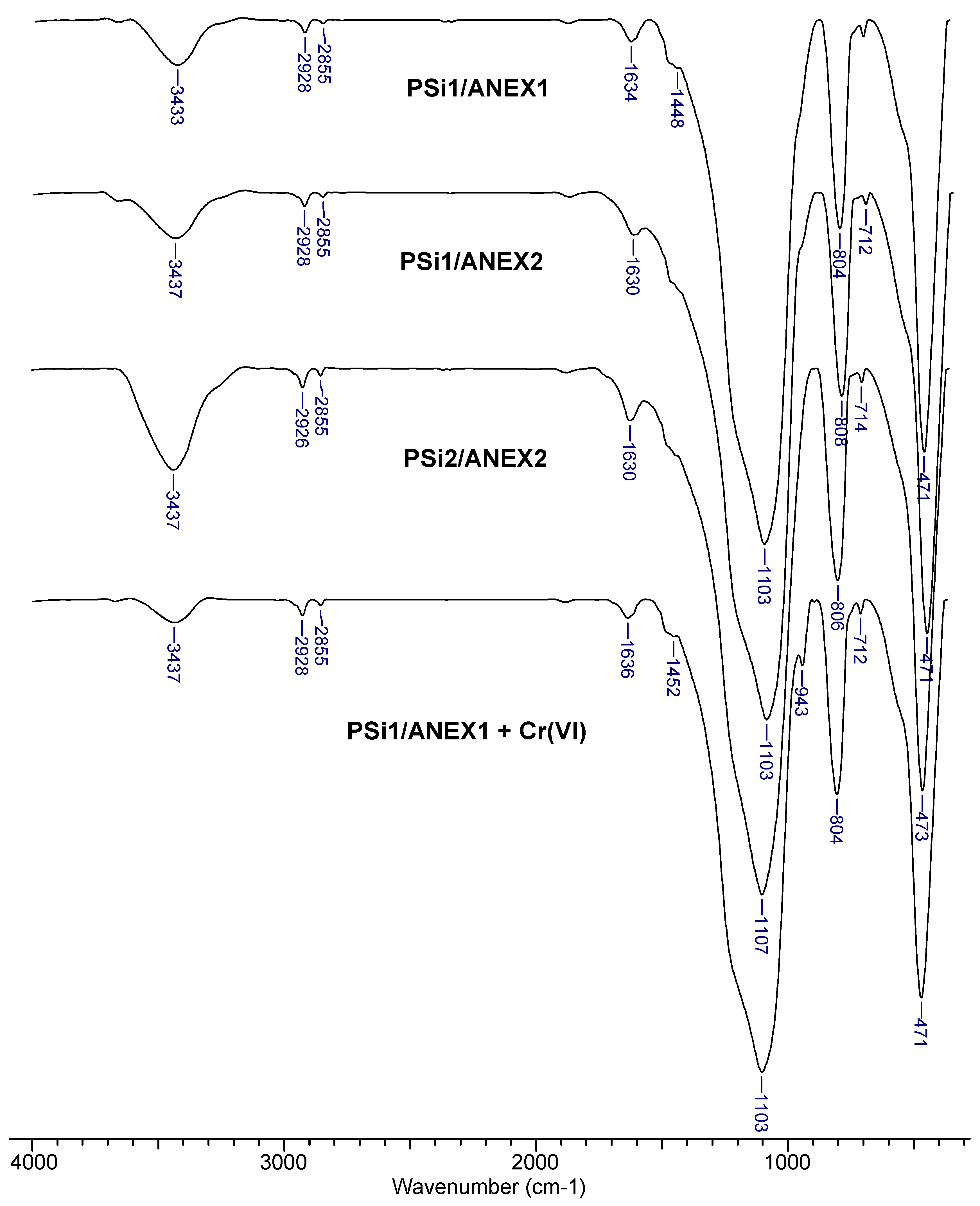


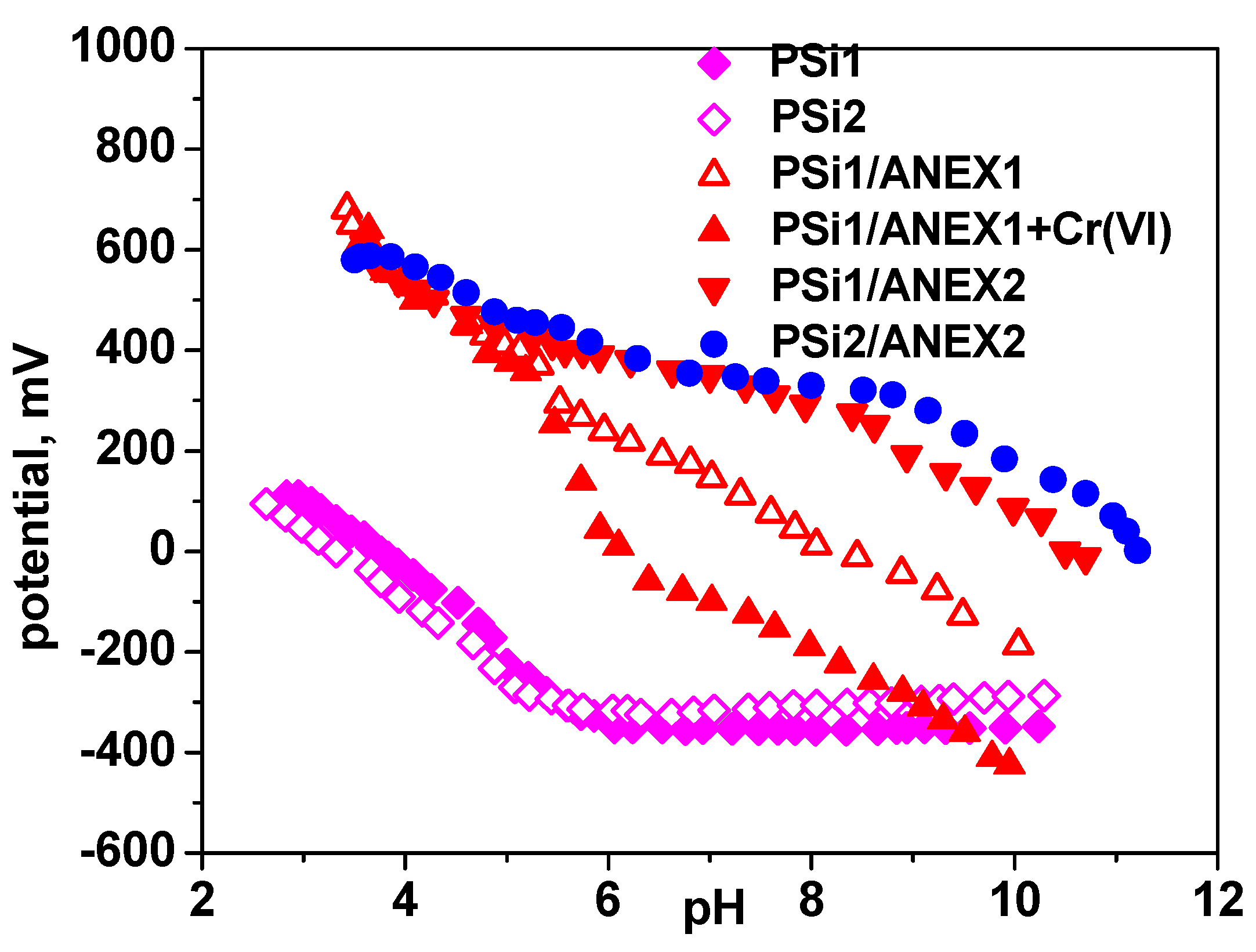
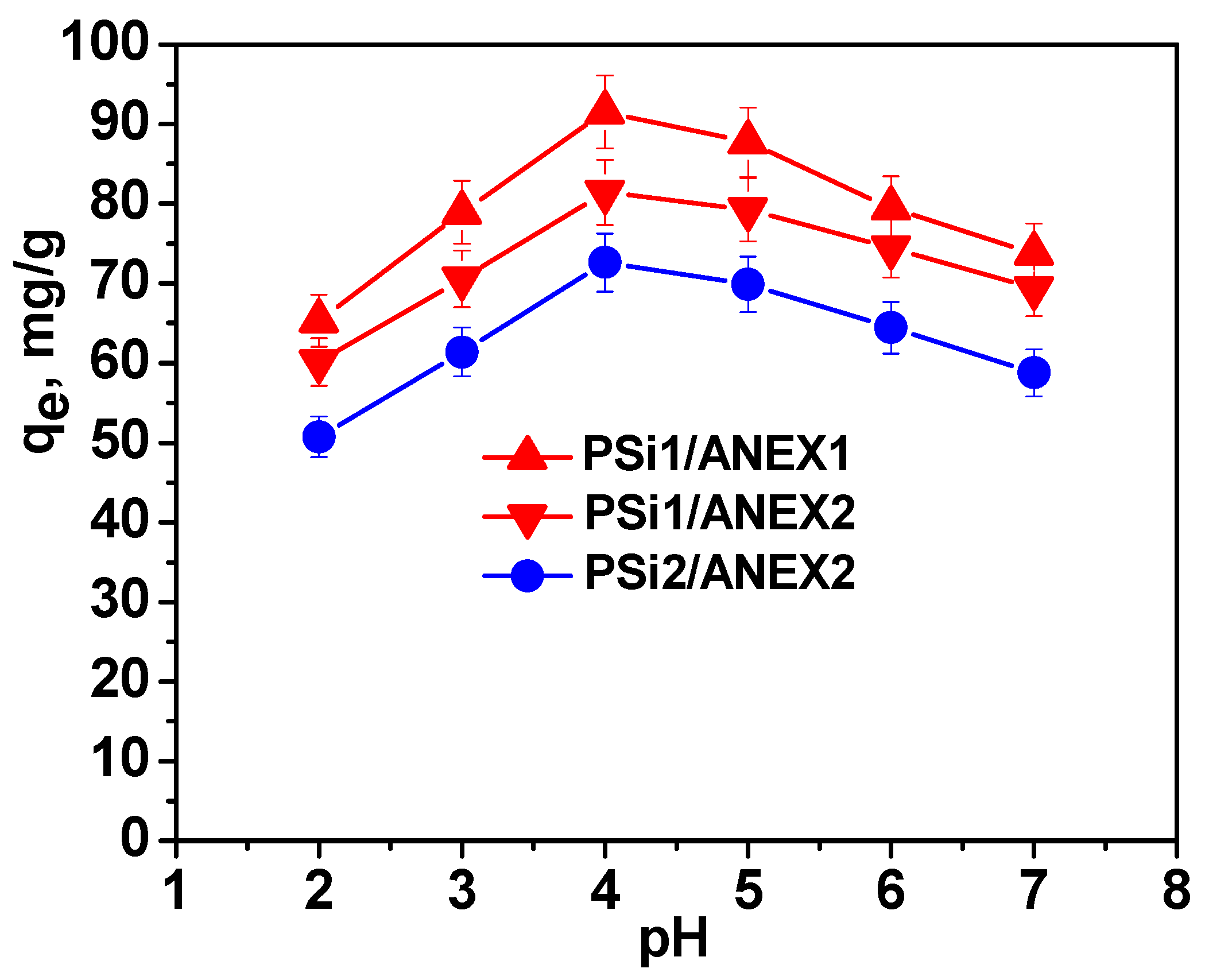
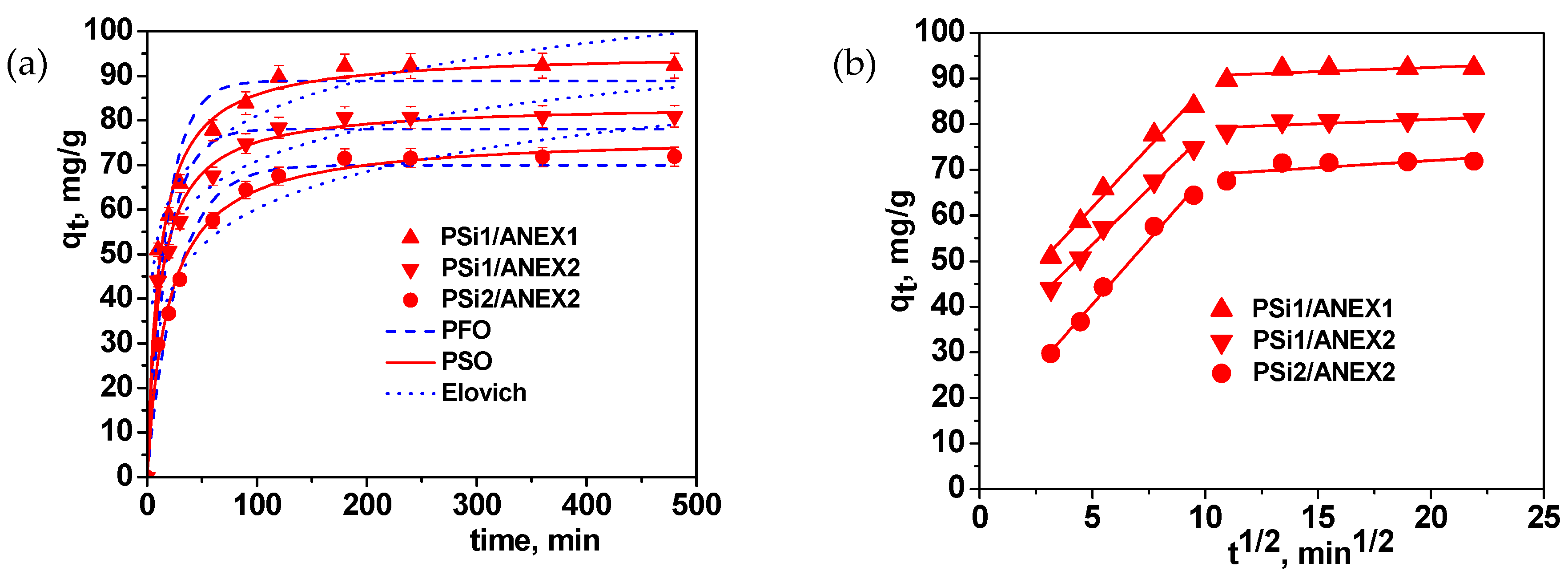
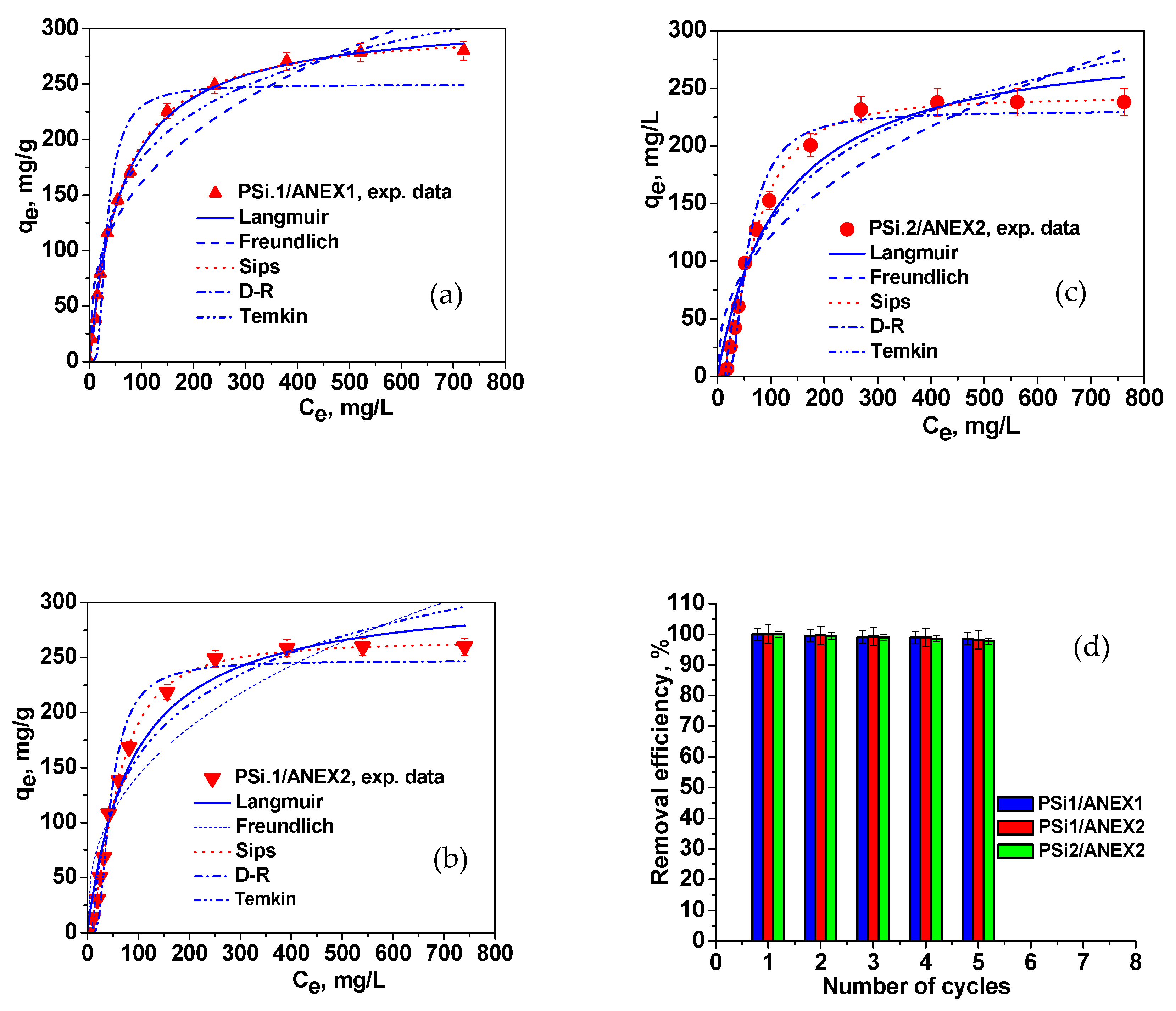
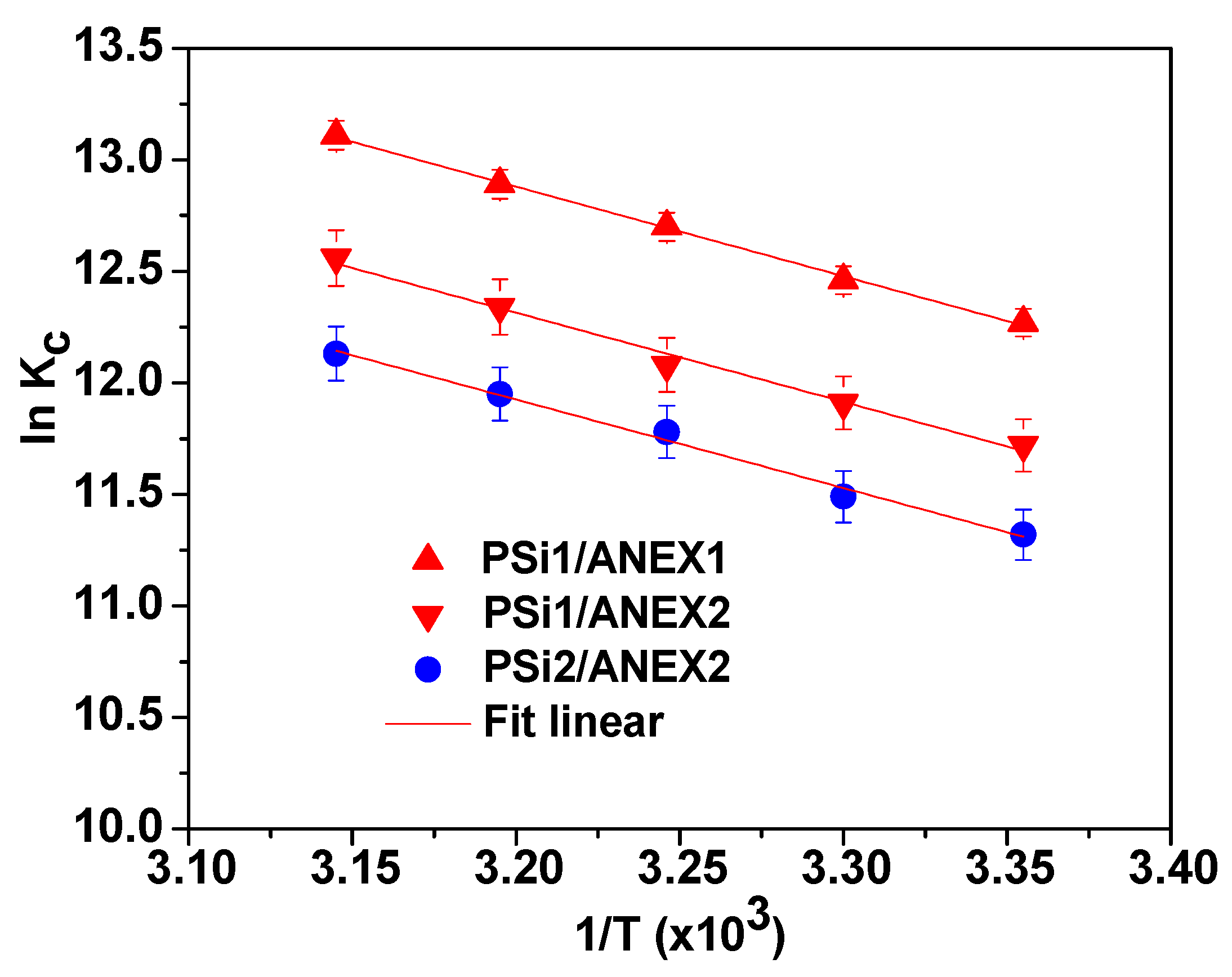
| Kinetic Model | Kinetic Parameters | PSi.1/ANEX1 | PSi.1/ANEX2 | PSi.2/ANEX2 |
|---|---|---|---|---|
| qe, exp. | 92.31 | 80.96 | 71.87 | |
| PFO | qe, cal. (mg/g) | 88.9 | 78.08 | 69.97 |
| k1 (min−1) | 0.0573 | 0.0553 | 0.0363 | |
| R2 | 0.9531 | 0.955 | 0.976 | |
| χ2 | 37.37 | 27.82 | 13.07 | |
| PSO | qe calc. (mg/g) | 95.26 | 83.75 | 76.75 |
| k2 (g/mg·min) | 9.494 × 10−4 | 0.001 | 6.74 × 10−4 | |
| R2 | 0.9895 | 0.9895 | 0.9925 | |
| χ2 | 8.4 | 0.46 | 4.1 | |
| Elovich | α (mg/g·min) | 115.29 | 88.19 | 17.76 |
| β (g/mg) | 0.0849 | 0.095 | 0.083 | |
| R2 | 0.9758 | 0.9738 | 0.9631 | |
| χ2 | 19.28 | 16.17 | 20.09 | |
| IPD model | kid.1, mg·g−1·min−0.5 | 5.274 | 4.888 | 5.63 |
| C1, mg·g−1 | 35.42 | 29.205 | 12.36 | |
| R12 | 0.9851 | 0.9928 | 0.9891 |
| Isotherm | Isotherm Parameters | PSi.1/ANEX1 | PSi.1/ANEX2 | PSi.2/ANEX2 |
|---|---|---|---|---|
| Langmuir | qm, mg/g | 311.2 | 311.78 | 299.19 |
| KL, L/mg | 0.01616 | 0.0115 | 0.00861 | |
| RL | 0.0062–0.712 | 0.0086–0.776 | 0.0115–0.2152 | |
| R2 | 0.9979 | 0.9704 | 0.9532 | |
| χ2 | 22 | 304 | 417 | |
| Freundlich | KF,mg1−1/n·L1/n·g−1 | 32.54 | 24.66 | 18.01 |
| 1/n | 0.3476 | 0.3816 | 0.4153 | |
| R2 | 0.9269 | 0.8659 | 0.8496 | |
| χ2 | 791 | 1378 | 1341 | |
| Sips | qm, mg/g | 301.55 | 265.19 | 242.19 |
| aS | 0.01243 | 9.71 × 10−4 | 2.679 × 10−4 | |
| 1/n | 1.086 | 1.7 | 1.937 | |
| R2 | 0.9985 | 0.9979 | 0.9956 | |
| χ2 | 16.4 | 21.4 | 38 | |
| D-R | qDR. mg/g | 249.4 | 247.29 | 230.1 |
| β, mol2/kJ2 | 1.348 × 10−4 | 2.51 × 10−4 | 3.95 × 10−4 | |
| E, kJ/mol | 60.9 | 44.63 | 35.58 | |
| R2 | 0.8910 | 0.9633 | 0.9747 | |
| χ2 | 1171 | 377 | 226 | |
| Temkin | aT, L/mg | 0.212 | 0.1057 | 0.0709 |
| bT, J/mol | 40.52 | 35.69 | 35.15 | |
| R2 | 0.9845 | 0.9604 | 0.9547 | |
| χ2 | 168 | 407 | 403 |
| Sorbent [ref] | Initial pH | T, °C | Sorbent Dose, g/L | qm, mg/g |
|---|---|---|---|---|
| Weakly basic anion exchange resin D301 modified with poly-epichlorohydrin-dimethylamine (EPIDMA) [22] | 2 | 25 | 0.6 | 194 |
| Macroporous copolymers of poly(glycidyl methacrylate-co-ethyleneglycol dimethacrylate functionalized with hexamethylene diamine (GMA-60 HD) [23] | 2 | 25 | 10 | 156 |
| Composites with strong base anion exchangers embedded into chitosan/poly(vinyl amine) cryogels [24] | 5.5 | 25 | 1.25 | 295.92 |
| Macroporous styrene-divinylbenzene matrix, functional group—+N(CH2CH3)2CH2CH2OH [25] | 5.5 | 25 | 1 | 313.81 |
| poly(N1,N1,N3,N3-tetraallylpropane-1,3-diaminium chloride) [26] | 3–7 | 20 | 1 | 273.17 |
| Macroporous anion exchange resin D301 [27] | 3 | 27 | 1.7 | 151.52 |
| Gels of poly[2-(dimethylamino)ethyl methacrylate] with bromethan [28] | 4.5 | 25 | 1 | 210.5 |
| Chitosan modified with cinnamaldehyde nanocomposites [32] | 2 | 25 | 3 | 61.35 |
| Hydroxyapatite microfibrillated cellulose composite [35] | 5 | 25 | 0.8 | 114.8 |
| Polyvinylpyrrolidone intercalated molybdenum disulfide [36] | 5 | 25 | 0.5 | 142.2 |
| Mesoporous silica MCM-41/PMMA [41] | 2 | 25 | 20 | |
| Polypyrrole-polyaniline nanofibers [49] | 2 | 25 | 1 | 227 |
| Polyacrylonitrile/polypyrole core/shell nanofiber mat [55] | 2 | 25 | 3.33 | 61.8 |
| Porous silica PSi.1/ANEX1 composite [this study] | 4 | 23 | 1 | 311.8 |
| Sorbent | ΔH, kJ/mol | ΔS, kJ/mol.K | ΔG, kJ/mol | ||||
|---|---|---|---|---|---|---|---|
| 298 K | 303 K | 308 K | 313 K | 318 K | |||
| PSi.1/ANEX1 | 33.4 | 0.214 | −30.37 | −31.44 | −32.51 | −33.58 | −34.65 |
| PSi.1/ANEX2 | 33.35 | 0.209 | −28.93 | −29.98 | −31.02 | −32.07 | −33.11 |
| PSi.2/ANEX2 | 32.96 | 0.205 | −28.13 | −29.16 | −29.79 | −31.21 | −32.23 |
© 2020 by the authors. Licensee MDPI, Basel, Switzerland. This article is an open access article distributed under the terms and conditions of the Creative Commons Attribution (CC BY) license (http://creativecommons.org/licenses/by/4.0/).
Share and Cite
Dragan, E.S.; Humelnicu, D. Contribution of Cross-Linker and Silica Morphology on Cr(VI) Sorption Performances of Organic Anion Exchangers Embedded into Silica Pores. Molecules 2020, 25, 1249. https://doi.org/10.3390/molecules25051249
Dragan ES, Humelnicu D. Contribution of Cross-Linker and Silica Morphology on Cr(VI) Sorption Performances of Organic Anion Exchangers Embedded into Silica Pores. Molecules. 2020; 25(5):1249. https://doi.org/10.3390/molecules25051249
Chicago/Turabian StyleDragan, Ecaterina Stela, and Doina Humelnicu. 2020. "Contribution of Cross-Linker and Silica Morphology on Cr(VI) Sorption Performances of Organic Anion Exchangers Embedded into Silica Pores" Molecules 25, no. 5: 1249. https://doi.org/10.3390/molecules25051249
APA StyleDragan, E. S., & Humelnicu, D. (2020). Contribution of Cross-Linker and Silica Morphology on Cr(VI) Sorption Performances of Organic Anion Exchangers Embedded into Silica Pores. Molecules, 25(5), 1249. https://doi.org/10.3390/molecules25051249





